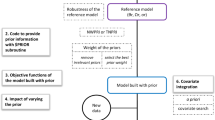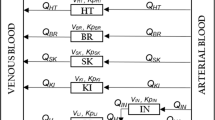Abstract
Markov chain Monte Carlo (MCMC) techniques have revolutionized the field of Bayesian statistics by enabling posterior inference for arbitrarily complex models. The now widely used WinBUGS software has, over the years, made the methodology accessible to a great many applied scientists, in all fields of research. Despite this, serious application of MCMC methods within the field of population PK/PD has been comparatively limited. We appreciate that for many applied pharmacokineticists the prospect of conducting a Bayesian analysis will require numerous alien concepts to be taken on board and it may be difficult to justify investing the time and effort required in order to understand them (especially since the approach is so computer-intensive). For this reason we provide here a thorough (but often informal) discussion of all aspects of Bayesian inference as they apply specifically to population PK/PD. We also acknowledge that while the WinBUGS software is general purpose, model specification for some types of problem, population PK/PD being a prime example, can be very difficult, to the extent that a specialized interface for describing the problem at hand is often a practical necessity. In the latter part of this paper we describe such an interface, namely PKBugs. A principal aim of the paper is to offer sufficient technical background, in an easy to follow format, that the reader may develop both the confidence and know-how to make appropriate use of the PKBugs/WinBUGS framework (or similar software) for their own data analysis needs, should they choose to adopt a Bayesian approach.
Similar content being viewed by others
REFERENCES
N. G. Best, D. J. Spiegelhalter, A. Thomas, and C. E. G. Brayne. Bayesian analysis of realistically complex models, J. R. Statist. Soc. A 159:323-342 (1996).
A. Gelman, J. B. Carlin, H. S. Stern, and D. B. Rubin. Bayesian Data Analysis, Chapman and Hall, London (1995).
W. R. Gilks, S. Richardson, and D. J. Spiegelhalter. Markov Chain Monte Carlo in Practice, Chapman and Hall, London (1996).
H. S. Migon and D. Gamerman. Statistical Inference: an Integrated Approach, Arnold, London (1999).
N. G. Best, K. K. C. Tan, W. R. Gilks, and D. J. Spiegelhalter. Estimation of population pharmacokinetics using the Gibbs sampler, J. Pharmacokin. Biopharm. 23:407-435 (1995).
P. Spector, An Introduction to S and S-PLUS, Duxbury Press, Belmont, CA (1994).
D. Spiegelhalter, A. Thomas, and N. Best, WinBUGS Version 1.3 User Manual, Medical Research Council Biostatistics Unit, Cambridge (2000).
J. Rasbash et al. A User's Guide to MLwiN (Second Edition), Institute of Education, London (2000).
S. L. Beal and L. B. Sheiner. NONMEM User's Guide, parts I-VII, NONMEM Project Group, San Francisco (1992).
M. O. Karlsson and L. B. Sheiner. The importance of modeling inter-occasion variability in population pharmacokinetic analyses, J. Pharmacokin. Biopharm. 21:735-750 (1993).
D. J. Lunn and L. J. Aarons. Markov chain Monte Carlo techniques for studying interoccasion and intersubject variability: application to pharmacokinetic data, Appl. Statist. 46:73-91 (1997).
J. C. Wakefield, A. F. M. Smith, A. Racine-Poon, and A. E. Gelfand. Basyesian analysis of linear and non-linear population models by using the Gibbs sampler, Appl. Statist. 43:201-221 (1994).
D. J. Spiegelhalter, N. G. Best, and B. P. Carlin. Bayesian deviance, the effective number of parameters, and the comparison of arbitrarily complex models, Technical Report, Medical Research Council Biostatistics Unit, Cambridge (1998).
A. E. Gelfand and M. Trevisani. Inequalities between expected marginal log likelihoods with implications for likelihood-based model comparison, Technical Report tr0038, Dept.of Statistics, University of Connecticut (2000).
S. L. Lauritzen, A. P. Dawid, B. N. Larsen, and H. G. Leimer. Independence properties of directed Markov fields, Networks 20:491-505 (1990).
J. Whittaker. Graphical Models in Applied Multivariate Analysis, John Wiley and Sons, Chichester (1990).
D. J. Spiegelhalter, A. P. Dawid, S. L. Lauritzen, and R. G. Cowell. Bayesian analysis in expert systems (with discussion), Statistical Science 8:219-283 (1993).
D. J. Lunn, A. Thomas, N. Best, and D. Spiegelhalter. WinBUGS-a Bayesian modeling framework: concepts, structure, and extensibility, Statistics and Computing 10:325-337 (2000).
G. R. Grimmett and D. R. Stirzaker. Probability and Random Processes, 2nd Edition, Oxford University Press, New York (1992).
S. Geman and D. Geman. Stochastic relaxation, Gibbs distributions and the Bayesian restoration of images, IEEE Trans. Pattn. Anal. Mach. Intell. 6:721-741 (1984).
A. E. Gelfand and A. F. M. Smith. Sampling-based approaches to calculating marginal densities, J. Am. Statist. Ass. 85:398-409 (1990).
N. Metropolis, A. W. Rosenbluth, M. N. Rosenbluth, A. H. Teller, and E. Teller. Equations of state calculations by fast computing machines, J. Chem. Phys. 21:1087-1091 (1953).
W. K. Hastings. Monte Carlo sampling-based methods using Markov chains and their applications, Biometrika 57:97-109 (1970).
W. R. Gilks. Full conditional distributions. In W. R. Gilks, S. Richardson, and D. J. Spiegelhalter (eds.), Markov Chain Monte Carlo in Practice, Chapman and Hall, London, 1996, pp. 75-88.
B. D. Ripley. Stochastic Simulation, John Wiley and Sons, New York (1987).
W. R. Gilks and P. Wild. Adapative rejection sampling for Gibbs sampling, Applied Statistics 41:337-348 (1992).
W. Gilks, Derivative-free adaptive rejection sampling for Gibbs sampling. In: J. M. Bernardo, J. O. Berger, A. P. Dawid, and A. F. M. Smith (eds.), Bayesian Statistics 4, Oxford University Press, Oxford, 1992, pp. 641-665.
R. M. Neal. Markov chain Monte Carlo methods based on ''slicing'' the density function, Technical Report 9722, Dept.of Statistics, University of Toronto (1997).
R. Natarajan and R. E. Kass. Reference Bayesian methods for generalized linear mixed models, J. Am. Statist. Ass. 95:227-237 (2000).
M. K. Cowles and B. P. Carlin. Markov chain Monte Carlo convergence diagnostics: a comparative review, J. Am. Statist. Ass. 91:883-904 (1996).
K. L. Mengersen, C. P. Robert, and C. Guihenneuc-Jouyaux. MCMC convergence diagnostics: a reviewww, in Bayesian Statistics 6, J. M. Bernardo, J. O. Berger, A. P. Dawid, and A. F. M. Smith (eds.), pp. 415-440, Oxford University Press, Oxford (1999).
N. G. Best, M. K. Cowles, and S. K. Vines. CODA: Convergence Diagnosis and Output Analysis software for Gibbs Sampler output: Version 0.3, Medical Research Council Biostatistics Unit, Cambridge (1995).
B. J. Smith. Bayesian Output Analysis Program (BOA) Version 0.5.0 User Manual, Department of Biostatistics, University of Iowa College of Public Health, Iowa City (2000).
A. Gelman and D. B. Rubin. Inference from iterative simulation using multiple sequences (with discussion), Statistical Science 7:457-511 (1992).
S. P. Brooks and A. Gelman. Alternative methods for monitoring convergence of iterative simulations. J. Comput. Graph. Stat. 7, 434-455 (1998).
S. L. Beal. Ways to fit a PK model with some data below the quantification limit, J. Pharmacokin. Pharmacodyn. 28, 481-504 (2001).
J. C. Wakefield. An expected loss approach to the design of dosage regimens via samplingbased methods, The Statistician 43:13-29 (1994).
H. Akaike. A new look at statistical model identification, IEEE Trans. Auto. Cont. AU-19:716-722 (1974).
P. J. Green. Reversible jump Markov chain Monte Carlo computation and Bayesian model determination, Biometrika 82:711-732 (1995).
A. H. Thomson, S. Way, S. M. Bryson, E. M. McGovern, A. W. Kelman, and B. Whiting. Population pharmacokinetics of gentamicin in neonates, Dev. Pharm. Therapeutics 11:173-179 (1988).
R. M. Neal. Suppressing random walks in Markov chain Monte Carlo using ordered overrelaxation. In M. I. Jordan (ed.), Learning in Graphical Models, Kluwer Academic Publishers, Dordrecht, 1998, pp. 205-225.
D. J. Lunn and L. Aarons. The pharmacokinetics of saquinavir: a Markov chain Monte Carlo population analysis, J. Pharmacokin. Biopharm. 26:47-74 (1998).
J. Besag, P. J. Green, D. Higdon, and K. Mengersen, Bayesian computation and stochastic systems (with discussion), Statistical Science 10:3-66 (1995).
D. J. Lunn, J. Wakefield, A. Thomas, N. Best, and D. Spiegelhalter, PKBugs User Guide Version 1.1, Dept. Epidemiology and Public Health, Imperial College School of Medicine, London (1999).
P. Diggle and M. G. Kenward. Informative drop-out in longitudinal data analysis (with discussion), Appl. Statist. 43:49-93 (1994).
L. B. Sheiner, S. L. Beal, and A. Dunne, Analysis of nonrandomly censored ordered categorical longitudinal data from analgesic trials, J. Am. Statist. Ass. 92:1235-1244 (1997).
J. Richard, J. M. Cardot, and J. Godbillon. Inter-and intra-subject variability of metoprolol kinetics after intravenous administration, Eur. J. Drug Metab. Pharmakinet. 19, 157-162 (1994).
J. E. Bennett and J. C. Wakefield. A comparison of a Bayesian population method with two methods as implemented in commercially available software, J. Pharmacokin. Biopharm. 24:403-432 (1996).
L. Aarons. Software for population pharmacokinetics and pharmacodynamics, Clin. Pharmacokin. 36:255-264 (1999).
Author information
Authors and Affiliations
Rights and permissions
About this article
Cite this article
Lunn, D.J., Best, N., Thomas, A. et al. Bayesian Analysis of Population PK/PD Models: General Concepts and Software. J Pharmacokinet Pharmacodyn 29, 271–307 (2002). https://doi.org/10.1023/A:1020206907668
Issue Date:
DOI: https://doi.org/10.1023/A:1020206907668




